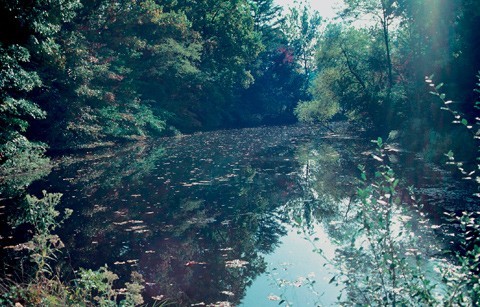
Today Swan Cove is a small, abayed pond. Three hundred and fifty years ago it was probably navigable for small boats—the main form of transportation for the Puritan settlement of Providence. (Photo, Al Luckenbach.)
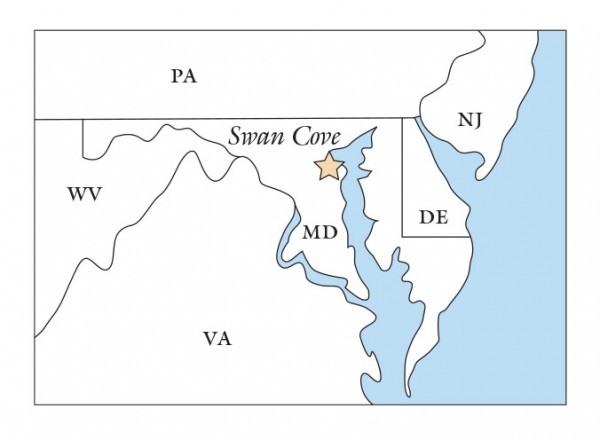
The Swan Cove kiln site was discovered in Anne Arundel County, Maryland, on the western shore of the Chesapeake Bay.
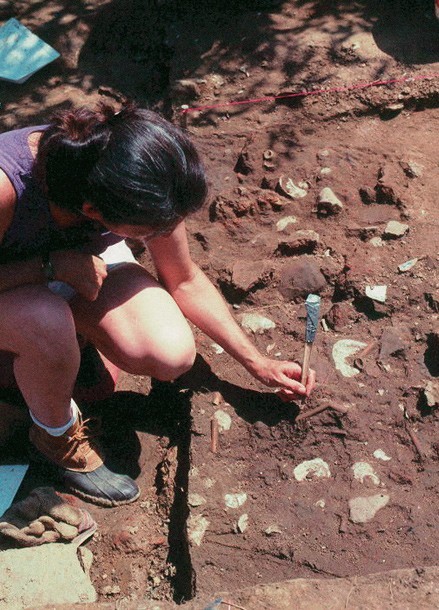
Anne Arundel County’s Historic Sites Planner, Donna Ware, excavates Feature 19 at Swan Cove. This feature was one of several undisturbed trash pits filled with pipe kiln debris and wasters. (Photo, Al Luckenbach.)

Emanuel Drue’s 1669 estate inventory listing. (Courtesy, Maryland State Archives.)

A detail from Feature 7 at Swan Cove shows muZe fragments, loaves, a prop, glazed cobbles, and pipe wasters, along with domestic debris such as oysters and delftware sherds. Feature 7 contained over 160 pounds of kiln debris along with nearly 1,200 pipe fragments. (Photo, Al Luckenbach.)
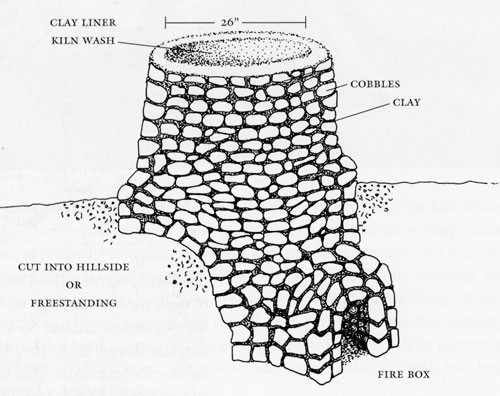
Conjectural drawing of the Emanuel Drue pipe kiln. (Drawing, Lost Towns Project, Anne Arundel County, Maryland.)
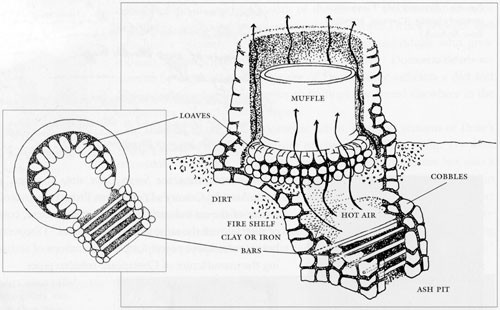
Conjectural drawing of the Emanuel Drue pipe kiln. (Drawing, Lost Towns Project, Anne Arundel County, Maryland.)
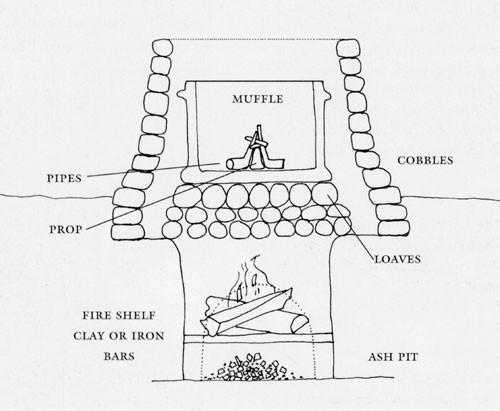
Conjectural drawing of the Emanuel Drue pipe kiln showing the placement of the muffle and the interior arrangement of the pipes and props. (Drawing, Lost Towns Project, Anne Arundel County, Maryland.)

Crude, handmade, redware objects roughly the size and shape of bread were given the term loaves. These apparently took the place of more traditional bricks in the kiln’s flooring and perhaps its sides. (Photo, Gavin Ashworth.)

Numerous non-native quartzite cobbles, many of which display heat alterations, litter the Swan Cove site. The vitrified surface of this extreme example clearly indicates their use as part of the kiln’s construction. (Photo, Gavin Ashworth.)
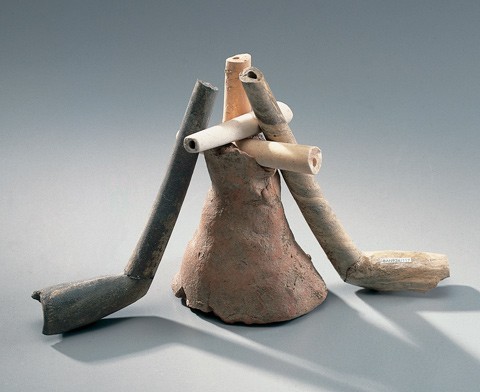
A redware cross-pipe prop was built incorporating broken pipe stem fragments and used to brace tobacco pipes during the firing of Emanuel Drue’s kiln. Two examples were recovered. (Photo, Gavin Ashworth.)
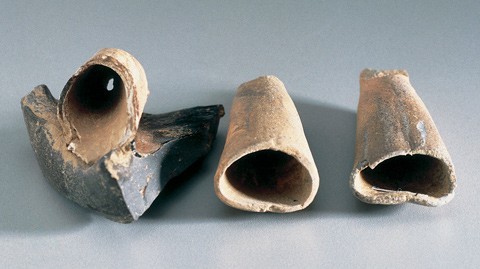
Pipe bowl wasters demonstrating distortion caused during firing while leaning against cross-pipe props. (Photo, Gavin Ashworth.)
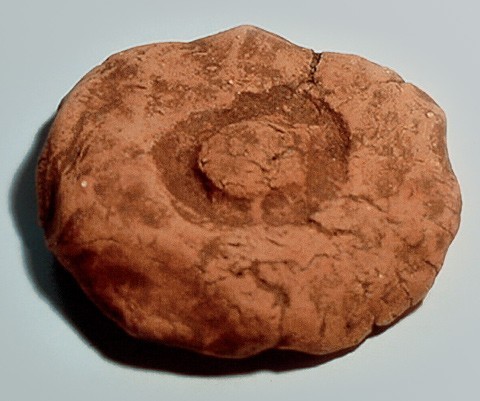
A redware object called a “bun,” which may have been used to stack props. (Photo, Al Luckenbach.)
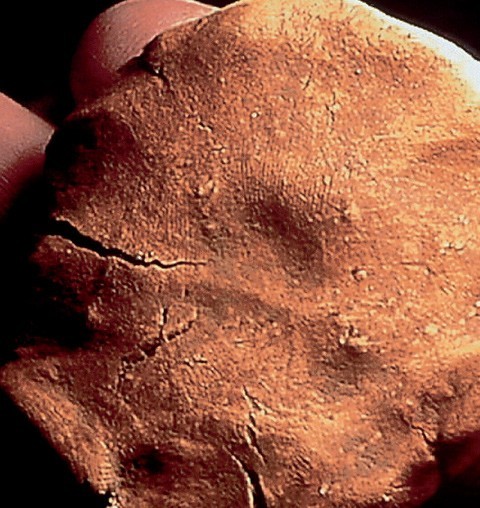
The reverse side of the bun bears the clear impressions of finger and palm prints. Presumably these belong to Emanuel Drue, imprinted over 350 years ago. (Photo, Al Luckenbach.)
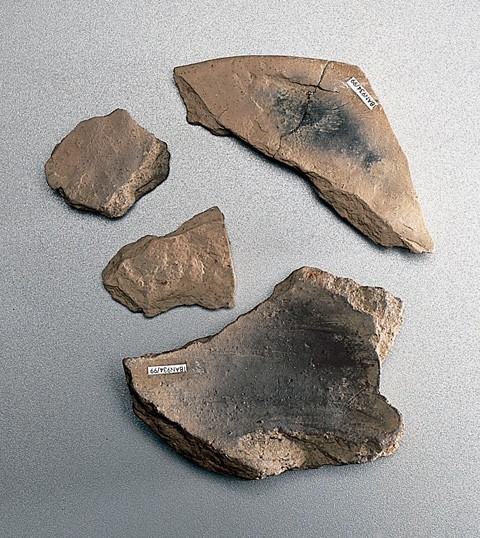
A crude, highly fired redware dish, which Emanuel Drue presumably made for some expedient purpose involving pipe making. (Photo, Gavin Ashworth.)
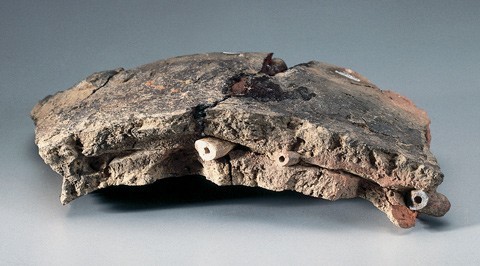
A fragment of the muffle showing the utilization of broken pipe stems as a bond between coils during construction. (Photo, Gavin Ashworth.)

Muffle sherd from the side showing herringbone pattern produced with pipe stems on alternating coils. (Photo, Gavin Ashworth.)
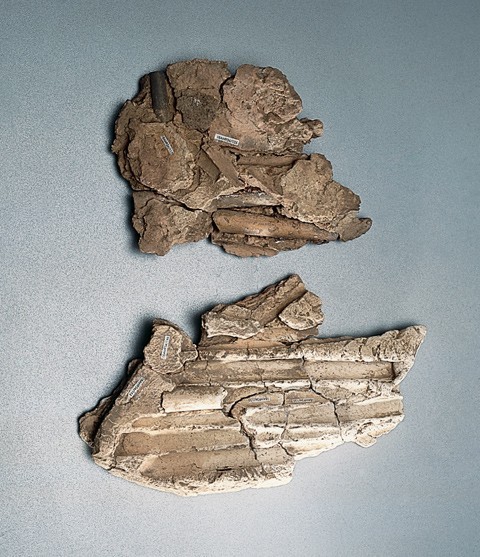
The interior base of each muffle contained layers of broken pipe stems. (Photo, Gavin Ashworth.)
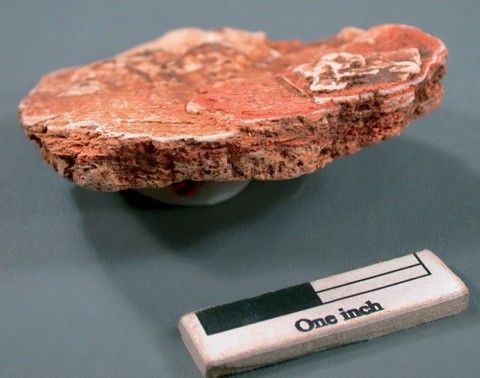
Repeated application of a clay wash on the muffle interior produced a laminar structure called “lute.” (Photo, David Gadsby.)

The Drue tobacco pipe Type A is a typical Chesapeake-style angular-elbow pipe. (Photo, Gavin Ashworth.)
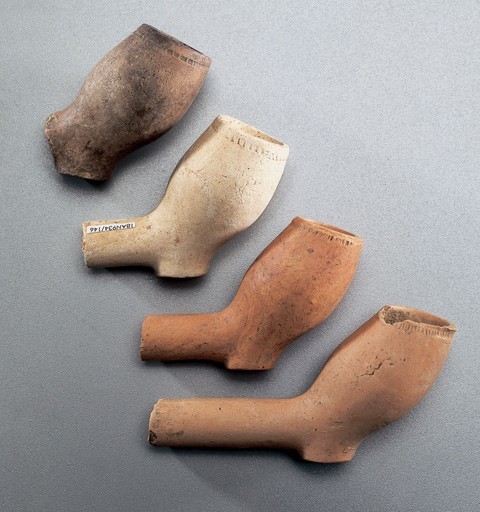
Drue’s Type B tobacco pipe is in the form of a classic English “belly bowl,” typical of the mid-seventeenth century. (Photo, Gavin Ashworth.)

Variations of Chesapeake-style decoration appearing on Drue Type A pipe examples. (Photo, Gavin Ashworth.)
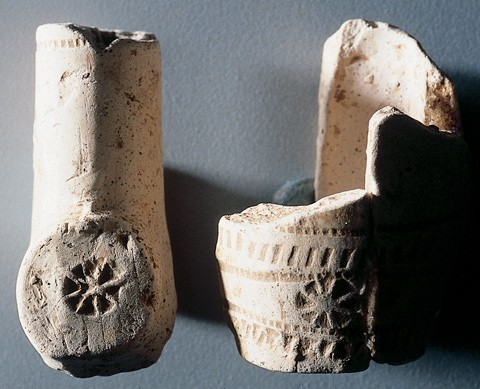
Unique examples of exuberant Chesapeake-style decoration on Drue Type B, perhaps representing a single specimen. (Photo, Gavin Ashworth.)

Three different stamps were utilized by Emanuel Drue in the production and decoration of his pipes. These have been termed Stamp Types 1, 2, and 3. (Photo, Gavin Ashworth.)

Three different stamps were utilized by Emanuel Drue in the production and decoration of his pipes. These have been termed Stamp Types 1, 2, and 3. (Photo, Gavin Ashworth.)

Three different stamps were utilized by Emanuel Drue in the production and decoration of his pipes. These have been termed Stamp Types 1, 2, and 3. (Photo, Gavin Ashworth.)
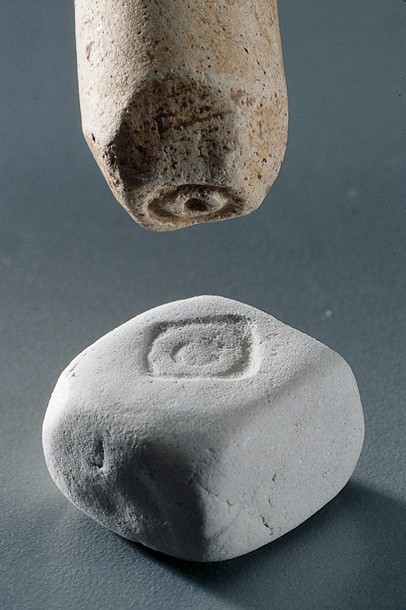
Stamp tool found at Swan Cove that was used to produce Type 1. This frequently utilized tool was found broken in half and appears to be constructed from an unbored pipe stem. (Photo, Gavin Ashworth.
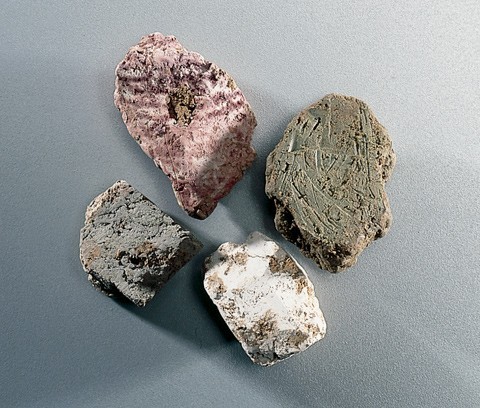
Raw, unfired clay from intact feature deposits at Swan Cove. These “gourmet clays” were utilized by Drue to produce products that were amazingly variable in color. (Photo, Gavin Ashworth.)
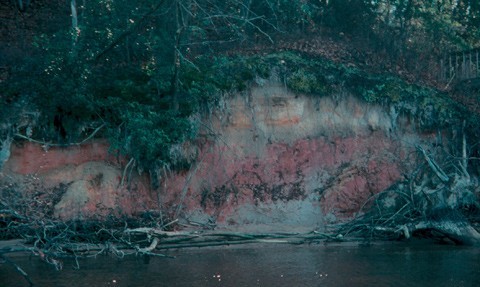
Source of white, pink, and green clays exposed on the banks of the Severn River that were exploited by Drue. This bank is located over thirteen miles away from Swan Cove. (Photo, C. Jane Cox.)
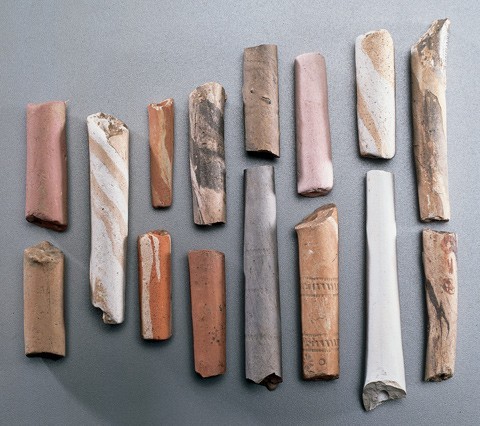
Tobacco pipe stems, Emanuel Drue, Maryland. Examples of the myriad color variations achieved by Drue through the mixing of diVerent color clays as well as slipping their exteriors. (Photo, Gavin Ashworth.)
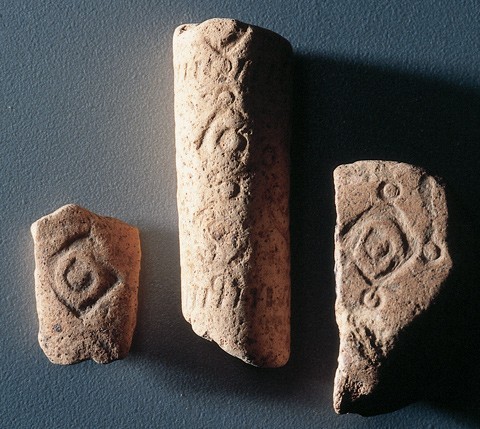
Three pieces of a pipe with a distinctive, very large heel termed Drue Type C. These sherds were excavated at the Burle Site at Providence nearly a decade before the stamp itself was recovered at Swan Cove. (Photo, Gavin Ashworth.)
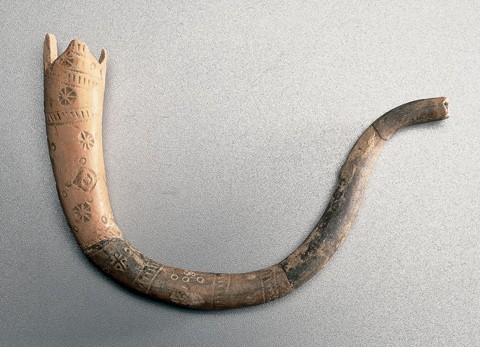
Drue Type D. (Photo, Gavin Ashworth.) Called a “crumm horn” (or crooked horn) pipe in Holland, this example is assumed to be one of Drue’s presentation pieces. It is a unique form, with ninety-four separate decorative elements.
